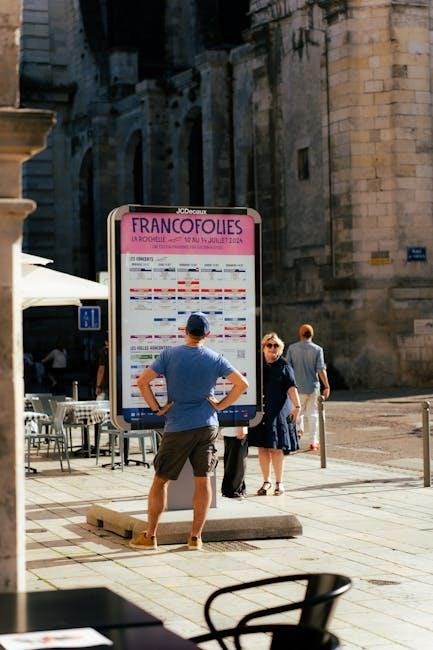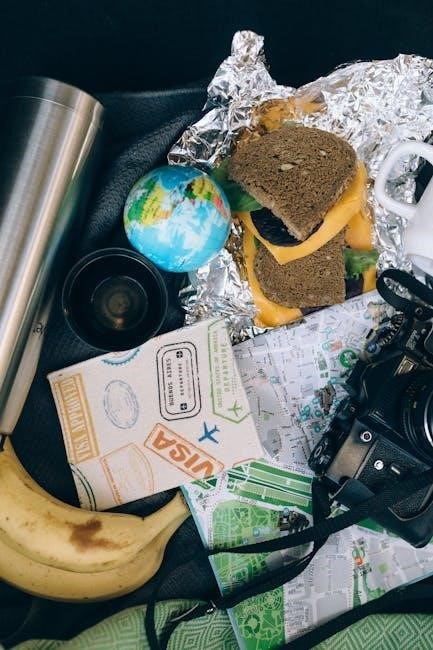Decluttering and minimalism offer a pathway to a simpler, more organized life. By removing unnecessary items, individuals can reduce stress, improve focus, and embrace sustainability. This guide provides practical steps to help you declutter effectively, making minimalism a sustainable lifestyle choice.
Why Decluttering is Essential in Modern Life
Decluttering is crucial in today’s fast-paced world, where excess can lead to stress and disorganization. By removing unnecessary items, individuals can improve focus, reduce anxiety, and save time. It also promotes financial savings and sustainability by encouraging mindful consumption. Decluttering helps create a calmer, more efficient living or working space, aligning with modern values of simplicity and functionality.
Understanding Minimalism: More Than Just a Trend
Minimalism is a lifestyle choice that emphasizes living with intention and purpose. It’s about valuing what truly matters and letting go of the rest. Beyond a design aesthetic, minimalism fosters clarity, reduces distractions, and promotes sustainability. By focusing on what adds value, individuals can create a meaningful life with fewer possessions, aligning with modern desires for simplicity and fulfillment.

Assessing Your Belongings
Evaluating your possessions is the first step in decluttering. Sort items into categories, asking if they bring joy or serve a purpose. Be honest about sentimental attachments to decide what to keep or discard, ensuring only meaningful or essential items remain.
How to Decide What to Keep and What to Discard
Deciding what to keep or discard involves evaluating each item’s purpose and emotional value. Ask if it sparks joy or serves a functional need. If an item is broken, duplicates another, or hasn’t been used in a year, consider letting it go. Be ruthless with items that no longer align with your lifestyle or goals. This mindful approach ensures only meaningful possessions remain.
Creating a Criteria List for Valuable Items
A criteria list helps determine an item’s value. Ask if it sparks joy, serves a purpose, or holds sentimental worth. Consider its condition, rarity, and whether it aligns with your lifestyle. Items that are broken, outdated, or unused should be discarded. This structured approach ensures only meaningful possessions remain, making decluttering more intentional and effective. It also helps maintain focus on what truly adds value to your life.

Step-by-Step Guide to Decluttering
Start with a clear plan, assess belongings, and organize supplies. Tackle small areas, sort items, and create routines to maintain your space effectively over time.
Gathering Necessary Supplies
To begin decluttering, gather essential supplies like sturdy boxes, trash bags, markers, and a label maker. Use a decluttering calendar for organization. Consider storage solutions for items you wish to keep. Ensure you have a designated area for donations, recycling, and trash. Having the right tools will streamline the process and keep you focused. A well-prepared workspace helps maintain efficiency and motivation throughout your decluttering journey.
Starting Small: Tackle One Area at a Time
Begin your decluttering journey by focusing on one small space or category of items at a time. This prevents overwhelm and builds momentum. Start with an area like your desk or closet, sorting items into keep, donate, sell, and discard piles. Use a decluttering calendar to break tasks into manageable steps. Celebrate progress, no matter how small, to stay motivated and maintain consistency. This approach makes the process feel achievable and sustainable over time.
Handling Sentimental and Difficult Items
When faced with sentimental items, consider their emotional value versus practical use. Create a memory box for cherished items to limit clutter. Set a cap on keepsakes to avoid overwhelm. For difficult decisions, ask if the item brings joy or serves a purpose. Let go of items that cause guilt or discomfort. Involve a trusted friend for perspective. Remember, the memory remains even if the item doesn’t. Keep only what truly resonates with you.
Options for Disposal
Dispose responsibly by donating, selling, or recycling items. Give to charities, sell through platforms, or recycle materials. Ensure items are handled ethically and sustainably, reducing waste effectively.
Donation: Giving Back to the Community
Donation is a meaningful way to give back by donating gently used items to charities, shelters, or community groups. It helps those in need while reducing waste. Many organizations accept clothing, furniture, and household goods, providing essential resources to others. Donating also offers tax deductions in some cases, benefiting both the giver and receiver. This act fosters a sense of purpose and contributes positively to society, aligning with sustainable and ethical practices.
Selling Items: Making Extra Cash
Selling items is a practical way to declutter while earning extra cash. Platforms like eBay, Facebook Marketplace, and local flea markets offer opportunities to turn unwanted goods into income. Researching market value ensures fair pricing, and setting a threshold, like $25 or more, helps decide what’s worth selling. This method not only declutters but also provides financial benefits, making it a win-win for both the seller and the buyer.
Recycling and Responsible Disposal
Responsible disposal is key to sustainability. Recycling ensures materials like paper, glass, and metal are repurposed, reducing environmental impact. Donate items in good condition to those in need or organizations. For broken or unusable items, use eco-friendly disposal methods or designated facilities. This approach minimizes landfill waste and promotes a greener lifestyle, aligning with the principles of minimalism and sustainability.

Organizing What’s Left
After decluttering, organizing involves creating systems for what remains. Use storage solutions to maximize space and ensure easy access. Maintain routines to keep your environment tidy and functional.
Effective Storage Solutions
Effective storage solutions involve using multi-functional furniture and clear containers to maximize space. Labeling and accessibility are key to maintaining organization. Utilize vertical space with shelves and ensure items are easily reachable. Implementing these strategies creates a clutter-free environment, making maintenance simpler and promoting a more organized lifestyle. By thoughtfully selecting storage options, you can efficiently manage what remains after decluttering, ensuring everything has a designated place.
Creating Maintenance Routines
Establishing daily habits, like tidying for 10 minutes, helps prevent clutter buildup. Schedule weekly decluttering sessions and use checklists to track progress. Regularly review stored items to ensure they remain useful or meaningful. Implement a ‘one in, one out’ policy to maintain balance. Seasonal decluttering can also refresh spaces. Consistent routines foster a sustainable, organized lifestyle, reducing stress and saving time in the long run.

Benefits of Embracing Minimalism
Embracing minimalism reduces stress, saves money, and fosters clarity. It encourages intentional living, freeing time and energy for what truly matters, leading to a more fulfilling life.
Emotional Benefits: Reducing Stress
Decluttering reduces stress by eliminating overwhelm and anxiety caused by clutter. A tidy environment promotes mental clarity, fostering a sense of calm and control. Minimalism encourages gratitude for what you have, shifting focus from consumption to contentment. By letting go of unnecessary items, you create space for what truly matters, improving emotional well-being and reducing feelings of chaos in daily life.
Financial Benefits: Saving Money
Decluttering and minimalism save money by reducing unnecessary purchases and extending the life of belongings. Selling unused items generates cash, while donating or repurposing reduces waste. Minimalism discourages impulse buying, helping you avoid costly duplicates. Additionally, maintaining and replacing fewer items lowers long-term expenses, allowing you to allocate resources more wisely and achieve financial stability.

Sustainability and Decluttering
Decluttering promotes sustainability by reducing waste and promoting mindful consumption. Donating, recycling, and repurposing items support eco-friendly practices and contribute to a greener lifestyle.
Eco-Friendly Disposal Methods
When decluttering, eco-friendly disposal methods are essential for sustainability. Consider recycling, donating, or repurposing items to reduce waste. Composting organic materials and properly disposing of hazardous waste also support environmental health. Avoid single-use items and opt for biodegradable alternatives. Check local guidelines for e-waste and chemical disposal. By choosing eco-conscious practices, you minimize landfill contributions and promote a greener lifestyle.
Adopting Sustainable Habits
Adopting sustainable habits begins with mindful consumption and reducing waste. Prioritize buying second-hand items and choose products with minimal packaging. Regularly reassess your belongings to prevent clutter buildup; Implementing a “one in, one out” policy ensures a balanced lifestyle. Educate yourself on sustainable practices and support eco-friendly brands. By making these changes, you contribute to a healthier environment while maintaining a clutter-free, minimalist space.

Special Considerations
Decluttering often involves emotional or bulky items, requiring thoughtful strategies. Prioritize decision-making frameworks and maintain motivation by celebrating small wins. Organize items methodically and seek support when needed.
Decluttering for a Move
Decluttering before a move reduces costs and stress. Start by sorting items into keep, sell, donate, and discard piles. Focus on essentials, and let go of unused or broken items. Selling items can offset moving expenses, while donating benefits others. Create a “moving binder” to organize documents, and label boxes clearly. This process ensures a smoother transition and a fresh start in your new space. Stay organized and focused throughout the process.
Helping Others Declutter
Helping others declutter can be challenging but rewarding. Start by understanding their attachment to items and guide them gently. Encourage sorting into categories like keep, donate, or discard. Respect their decisions while offering practical advice. Suggest focusing on items that bring joy or serve a purpose. Celebrate small victories to keep motivation high. Remember, decluttering is emotional, so patience and empathy are key to supporting others effectively.

Tools and Resources
Utilize apps like Decluttr or Letgo for selling items, and checklists for organizing tasks. Storage solutions and eco-friendly disposal guides also aid in sustainable decluttering.
Recommended Apps for Decluttering
Apps like Decluttr and Letgo simplify selling unwanted items, while TaskRabbit helps organize tasks. Trello and Todoist aid in tracking progress, and GoodOnYou supports ethical donations, streamlining your decluttering process efficiently.
Online Communities and Forums
Online platforms like Freecycle and local Facebook groups connect people for free item giveaways. Reddit’s r/declutter offers support and challenges, while Minimalist.org provides resources and inspiration. These communities foster accountability and share tips, helping individuals stay motivated and informed throughout their decluttering journey.
Embrace minimalism and decluttering to create a simpler, more organized life. Stay motivated by celebrating small victories and remembering the benefits of a clutter-free, stress-reduced environment.
Maintaining Your Space
Maintaining a clutter-free space requires consistent effort. Schedule regular cleanups, organize items thoughtfully, and create routines to keep your environment tidy. Use storage solutions wisely and adopt habits like the “one in, one out” rule to prevent clutter buildup. Regular maintenance ensures your space remains peaceful, functional, and aligned with your minimalist goals.
Staying Motivated
Staying motivated while decluttering requires setting clear goals and celebrating small victories. Track your progress, and remind yourself of the benefits, like reduced stress and a more organized space. Visualize your ideal lifestyle and how minimalism aligns with it. Share your journey with others for accountability and encouragement. Reward yourself for milestones achieved, and stay committed to your vision of a simpler, more intentional life.

Further Reading and Resources
For deeper insights, explore books like Marie Kondo’s The Life-Changing Magic of Tidying Up and Patricia Marx’s A Guide to Getting Rid of Almost Everything. Online resources such as minimalist blogs and YouTube channels offer practical tips. Join online communities like Facebook groups or Reddit forums dedicated to minimalism for support. Apps like Decluttr and Letgo can also help streamline your decluttering process. These tools will keep you informed and motivated on your journey to simplicity.